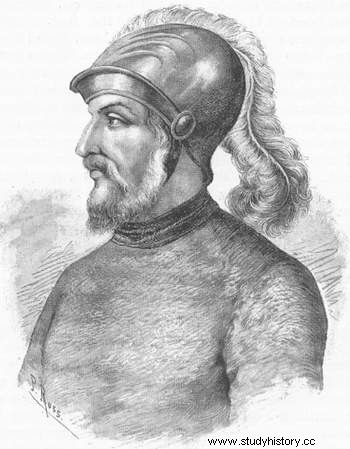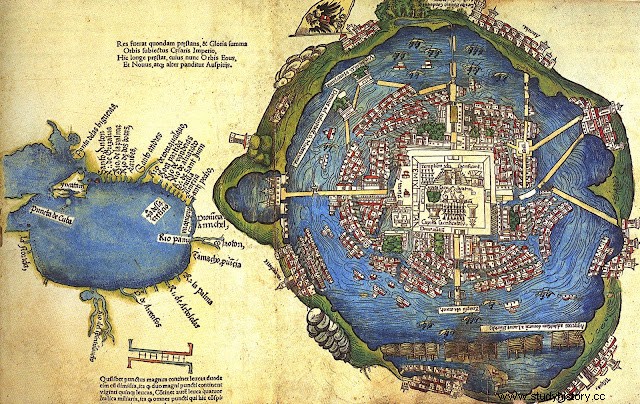Being the youngest of the Cortés captains, Sandoval participated in the conquest of New Spain (Mexico), standing out in the main battles of the Spanish.
 Gonzalo de Sandoval
Gonzalo de Sandoval He was born in Medellín (Badajoz) in 1497. As a teenager he sailed to the Indies in search of fortune. He was one of the initial settlers of the Cuban city of Trinidad, and it is known that, as he had knowledge as a master builder, he directed the first constructions of the town. At the beginning of 1519, he joined the conquering troop of Cortés, when the latter made a stopover in Trinidad, on his journey to the Yucatán.
It is said that he was a strong and broad-chested boy, without great ambitions for wealth but yes of fame, he lisped and stuttered when he spoke, which together with his rough appearance and his little knowledge, gave him a rough and ordinary air. However, he would reveal himself as an excellent captain and magnificent horseman, knowledgeable about the militia and, surely, Cortés's most trusted lieutenant. Bernal also tells that he owned the best horse of the Spaniards, called Motilla . Another chronicler of the conquest of Mexico, Vázquez de Tapia, says that he was very blasphemous, that he had denied Divine Providence and displayed his atheism.
Some time later, after the encounter with the Tlaxcatecas, the great chief Xicotencalt He offered his five maiden daughters to Cortés, and Cortés, in turn, gave the youngest to Sandoval as a special gift. Likewise, on November 9, 1519, when Cortés went to meet with Emperor Moctezuma, among the four captains chosen was the young Sandoval. And days later, when he made the decision to seize the Aztec capital and imprison the Emperor, he shared and discussed such a tricky issue with his closest circle of captains:Velázquez de León, Ordás, Alvarado and Sandoval.
 Moctezuma receiving Cortés
Moctezuma receiving Cortés Shortly thereafter he was appointed chief constable. In other words, in a few months and just before the conquest of Tenochtlitlán, the young soldier embarked in Trinidad was already one of Cortés's closest and most influential men.
He succeeded Alonso Grado in the government of Veracruz, and from there he organized the defense of the city against the imminent arrival of Pánfilo de Narváez's ships. The Veracruz garrison was defended by no more than sixty Spaniards, several of them wounded. Narváez, confident, sent three men he trusted to negotiate the surrender:the cleric Ruiz de Guevara, the notary Alonso de Vergara and the soldier Pedro de Amaya. Sandoval, without wrinkling, stopped them and sent them in shackles before Cortés.
Battles of Hispania Official Store
On the night of May 28, 1520, he led the attack on Narváez's camp in Cempoal, with orders to take him dead or alive. At dawn on the 29th, Sandoval took prisoner a defeated Narváez, badly wounded in one eye. But he didn't have much time to savor victory or take a break. After the events that began on May 16, and which converged in the massacre of the famous Noche Triste , Sandoval had to return to Tenochtiltlán to, together with Cortés, organize the resistance and subsequent Spanish flight from the city.
During the time that Cortes spent rebuilding his troops and reconquering the Aztec capital, Sandoval was in charge of captaining various expeditions. He marched to Veracruz to establish Spanish rule and secure the city as a rearguard and supply base. He colonized and subdued the Chalco Indians, managing to pacify that important territory between Tetzcuco and Tlaxcala. Later he went to Acolmán where he awaited orders while he was in charge of having the thirteen brigantines ready, which would be essential for the definitive capture of Tenochtiltán.
 The Sad Night was the only battle that the Mexica won against Hernán Cortés
The Sad Night was the only battle that the Mexica won against Hernán CortésDuring the siege of the city, Gonzalo de Sandoval was at the head of one of the three companies in which the conquering host was divided. It was made up, according to the chronicles, of twenty-four horses, thirteen crossbowmen, four men with arquebuses, one hundred and fifty foot soldiers and thirty thousand indigenous people. After being rejected, and after a month and a half of siege, on August 13 the final attack on the Aztec capital was launched. Sandoval was at the head of the brigantines and coordinated the attack from the waters surrounding the city. One of the men under his command, García Holguín, captured Cuauhtémoc (Moctezuma's successor and general of the Aztec troops), an honor Cortés himself appropriated by including it in his marquis's coat of arms.
Once the Aztec army, and taken Tenochtiltán by the Spaniards, some of the best lots and palaces were given to Sandoval in recognition of his military expertise and loyalty. This time he didn't enjoy his estate very much either, because at the end of the year he was already campaigning in the Coatzalcoalco region. There he subdued the natives of Tustepec, Huatusco and Oaxaca. He founded the towns of Medellin (in honor of his hometown) and the port of Espiritu Santo on the Pacific, and took the town of Guastalpetec for himself.
In 1523, he was in charge of putting down the Huaxteca rebellion, what he did in a brutal and bloody way looking for the sobering example. That same year, he led the first Spanish expedition to the coastal area of Jalisco, and on June 25 he founded the city of San Sebastián de Coloma. He also founded the town of San Esteban del Puerto, next to the mouth of the Panuco River. Always at his boss's side, he accompanied him in the Hibueras campaign, which began in October 1524, and entered the lands of southern Mexico that today belong to Honduras and Guatemala.
 The first European map of Tenochtitlán, 1524
The first European map of Tenochtitlán, 1524After more than a year of hard and fruitless exploration, He returned to Mexico, where he found a city full of riots and conspiracies, and a judge who had come from Spain to reside Cortés. Faced with this complex panorama, at the end of 1526 Sandoval was appointed chief justice, to maintain the power and influence of the conqueror in the affairs of the city. But his mandate lasted only a few months.
On March 17, 1528, he embarked for Spain together with Hernán Cortés. The sea voyage and some old wounds broke his health. He fell ill in an inn in Palos de la Frontera, where some bandits assaulted him, wounded him and stole thirteen gold bars that he was guarding . He was unable to recover and died a few days later. Thus, perhaps the most important figure in the conquest of Mexico, after Hernán Cortés, disappeared.
He died in 1528 in Niebla (Huelva) shortly after arriving in Spain. His remains were buried in the church of San Martín, in Niebla. Bernal Díaz del Castillo, his friend and his companion in battle, wrote that Sandoval was a good judge and a good administrator, as well as an excellent soldier.
